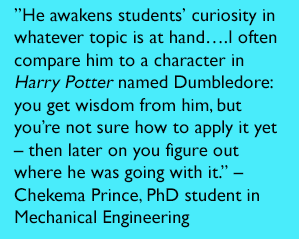Gordon Stubley: Authentic Teaching and Learning
 |
|
Gordon Stubley, Faculty of Engineering |
Written by Sarah Forbes, Special Projects (Teaching Stories), CTE.
(UPDATE: Gordon has retired from the University of Waterloo)
Since 1982, Dr. Gordon Stubley has been successfully integrating into his classroom the work that his Engineering students do on their cooperative work terms. He does this, he says, “by discouraging them from acting like students, and encouraging them to act like engineers.” This means that when they’re faced with a tough problem, he treats it like a work assignment and asks them to solve it with minimal guidance, just like they would do on the job. Most of his assignments are like this: they closely match what students have already experienced in the workplace. “By the time students get to me, they’ve already had a least two terms of work experience,” Stubley says. This means that he can assume they’ve previously handled tough problems outside of the classroom. His job is to extend their knowledge from their last work term to what they’re going to be expected to do on the next one.

In Stubley’s Fluid Dynamics course, he’s faced with students who are used to thinking about objects and movement through the perspective of solid items. Now, they are forced to change their way of thinking as they adapt to analysing the movement of fluid items such as water or oil. In order for them to understand the differences, he asks them to intuitively guess how something will behave, and then lets them observe how it actually acts. Often, their intuitive answer turns out to be wrong, forcing them to reevaluate their previous beliefs about movement. This is one of his favourite ways to teach – watching students figure out how things work on their own allows him to sustain his motivation and interest in teaching. “I get a real charge out of watching students work around an idea,” he explains. “When they finally grasp it and use it to do something new on their own, I know I did my job right.”
As well, he’s found that turning his own research ideas into forms that he can explain and teach his students allows him to make new connections, which is rewarding in itself. It’s these rewards that have sustained him through more than thirty years of teaching. Over his career, Stubley has watched the environment of the University of Waterloo change, developing more and more technology for teaching. Now, Stubley says, every class is accompanied by imagery and computer simulations – he no longer uses overheads to illustrate his lectures. The students have changed as well, according to Stubley. While he used to spend time training students on using technology, current students come in with a much higher base knowledge for using those tools. This allows him to spend more time actually using the technology to illustrate concepts of engineering.
Stubley originally undertook teaching to improve his communication and time management before entering the industry side of Engineering, but he quickly discovered that teaching was where he wanted to focus his energy. Now, he says, his classroom is an intense and busy place, perfect for developing both his own ideas and the ideas of his students. His decision to pursue teaching was evidently a good idea: he has received an Engineering Teaching Excellence Award, a 2007 Leadership in Faculty Teaching Award, a 2009 Distinguished Teacher Award, and a 2012 Ontario Undergraduate Student Alliance Award for Excellence in Teaching.
Update: Gordon Stubley has been named a 3M National Teaching Fellow. Read about why a student calls Stubley "the engineering Bill Nye" in the Waterloo Story, Engineering professor awarded prestigious teaching fellowship.
Read more Teaching Stories
More Resources
Listen to what students have to say about Gordon Stubley's teaching in this YouTube video.
CTE has developed more than 100 Teaching Tips. Each one is a succinct document that conveys useful ideas and practical methods for effective teaching. Some of the Teaching Tips that are relevant to the strategies mentioned in this Teaching Story include the following: